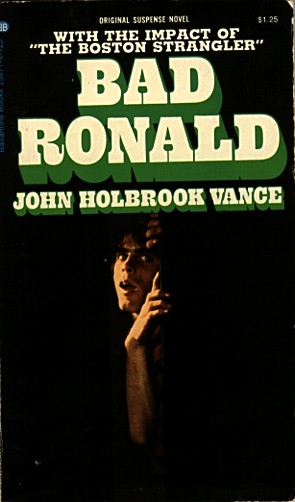 By JACK VANCE (Ballantine; 1973)
By JACK VANCE (Ballantine; 1973)
The incomparable Jack Vance is known primarily for picturesque science fiction, but he wrote equally potent mysteries. BAD RONALD, published under the author’s actual name John Holbrook Vance, was one of those (alleged) mystery novels. It’s a “hider in the house” tale in the mold of the 1989 film of the same name and THE PEOPLE UNDER THE STAIRS—as well as the so-so BAD RONALD TV movie adaptation from 1974—but it actually predated them by several decades, having been initially drafted back in the 1950s.
That latter fact is evident in BAD RONALD’S resolutely non-explicit descriptions of sex and violence, an approach that seems out of place in a 1973 publication (when Hubert Selby’s LAST EXIT TO BROOKLYN and David Morrell’s FIRST BLOOD had already opened the floodgates for extreme content in mainstream fiction). Yet the novel works nonetheless because Vance is so damn good, expertly drawing the reader in and keeping him riotously hooked until the end.
Ronald is a deeply maladjusted teen living with his aging mother in a California suburb. After raping and accidentally killing a young girl in his neighborhood, Ronald returns home—where he remains for the next several years, as his mother elects to “protect” Ronald from police by sealing him up in the downstairs bathroom.
Unfortunately the old woman dies just as Ronald is starting to get the hang of his new environment. He stays put, spending his days constructing a private fantasy world called Atranta.
In the outside world, meanwhile, Ronald’s house is sold and the Woods, a highly conservative family, move in. This brood includes three luscious girls who interest the increasingly horny Ronald to no end. He takes to spying on the Woods through a couple of specially made peep holes in his lair, and begins tentatively venturing out into the house with the aim of finally acting on his erupting hormones.
Vance showed particular daring in electing to tell his story largely from the confined Ronald’s point of view. This was necessary, of course, in conveying the minutiae of Ronald’s private universe, which Vance lays out with all the immersive detail of one of his sci fi sagas (complete with a hint of self-parody in Ronald’s creation of his imaginary fantasy world, an act with which Vance is evidently quite familiar). That Vance manages this without ever compromising the narrative momentum is a testament to his storytelling wizardry.
Ultimately, though, BAD RONALD works primarily because its protagonist is so compelling. Ronald may be a sexual deviant and murderous psychopath, but he’s also a resourceful, complex and tragic figure whose exploits always seem worth following, regardless of how dark and/or strange they become.
